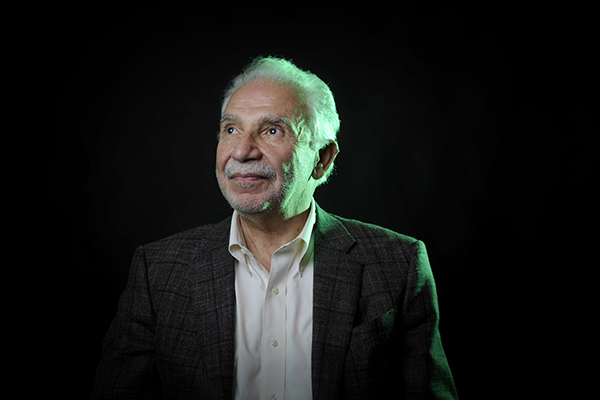Structure of the brain’s ‘marijuana receptor’ revealed

On Election Day, Nov. 8, recreational marijuana use could become legal in five more U.S. states, bringing the total number to eight plus the District of Columbia. Legal use of medical marijuana could jump to 27 states.
There’s been a seismic shift on the research side, too. New findings by an interdisciplinary team, including Northeastern’s Alexandros Makriyannis, reveal for the first time the structure of the receptor in the brain that leads to the high associated with THC—the psychoactive ingredient in marijuana.
The findings, published Thursday in Cell, open the door to the development of new medications, free from side effects, for conditions from pain and obesity to neurological diseases and addiction.
The work undertaken has required many years of collaboration in interdisciplinary research, and the leadership of professor Makriyannis has been central to this successful outcome.
—Kenneth Henderson, dean of the College of Science
“The elucidation of the three-dimensional structure of the receptor, called cannabinoid receptor 1, or CB1, marks a major breakthrough in the field, opening the potential for the directed discovery of new and more potent molecular therapies,” says Kenneth Henderson, dean of the College of Science. “The work undertaken has required many years of collaboration in interdisciplinary research, and the leadership of professor Makriyannis has been central to this successful outcome.”
Turning receptors on and off
THC, or tetrahydrocannabinol, belongs to a group of compounds called cannabinoids—substances found in the cannabis plant. These substances bind to and activate CB1, one of the most abundant receptors in the brain and body, to produce not just a high but also effects such as pain relief. The body produces similar compounds, called endocannabinoids, which bind to CB1 throughout the central and peripheral nervous system, maintaining the body’s internal equilibrium.
Knowing the detailed molecular structure of CB1 provides insight into how both natural and synthetic cannabinoids bind to the receptor, enabling researchers to craft drugs that bind “neatly”—that is, in a way that produces therapeutic benefits without negative side effects. Think of a lock (a receptor) and a key (a drug). The closer the fit, the more likely the safe will open (that is, activate the receptor) and lock (block the receptor should the aim be, say, to curb the craving of addiction).

Alexandros Makriyannis, George D. Behrakis Chair in Pharmaceutical Technology and director of Northeastern’s Center for Drug Discovery Photo by Matthew Modoono/Northeastern University
“We found that the CB1 receptor consists of multiple sub-pockets and channels,” says Makriyannis, George D. Behrakis Chair in Pharmaceutical Technology and director of Northeastern’s Center for Drug Discovery. “The crystallization of this complex structure will allow chemists to design diverse compounds that specifically target portions of the receptor to produce desired effects.”
A template for new drug development
To block and then crystallize receptors, a drug must be inserted within them. Makriyannis’ lab designed and synthesized the drug, called AM6538, that enabled the researchers to finally crystallize CB1 after many years of experiments. To determine CB1’s molecular shape, the interdisciplinary team then applied powerful X-rays to the crystal and measured the angles and intensities of the beams that bounced off of it. “The findings provide a template with which we can design new compounds for different afflictions, including metabolic disorders and liver fibrosis,” says Makriyannis.
They also contribute to research on substance abuse. As increasing numbers of locales legalize marijuana, understanding CB1’s binding and activation properties will provide clues about why natural THC appears so safe while synthetic cannabinoids such as Spice and K-2 can lead to severe, and even fatal, reactions.

A model of the CB1 receptor shows the structure of the receptor in green, along with the stabilizing molecule AM6538 in the central binding pocket. Model by Yekaterina Kadyshevskaya, Stevens Laboratory, USC
Kiran Vemuri, research assistant professor in the Center for Drug Discovery, synthesized AM6538, and Tian Hua, a graduate student at Shanghai Tech University, carried out the crystallization effort.
Makriyannis co-authored the paper with his close collaborator, crystallographer Raymond Stevens, provost professor and founding director of the Bridge Institute at the University of Southern California and professor at ShanghaiTech University; Zhi-Jie Lui, professor at ShanghaiTech University; and Laura M. Bohn, professor at the Scripps Research Institute. Stevens and Lui co-led the study.
This research, as well as novel developments in the field, will be presented at the Chemistry and Pharmacology of Drugs of Abuse meeting to be held at Northeastern on Aug. 12, 2017.





